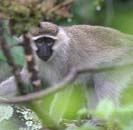Get
To Know
|
 The
Tantalus Monkey is an Old World monkey which traditionally ranges
from Senegal and Ethiopia to South Africa. More recently, a number of
them were carried by slavers to the Caribbean islands, along with enslaved
Africans. The monkeys subsequently escaped or were released and became
naturalized. The descendents of those populations are found on West Indian
islands and even in Florida. The dorsal fur of Chlorocebus monkeys varies
by species from pale yellow through grey-green brown to dark brown, while
the lower portion and the hair ring around the face is a whitish yellow.
Males have a blue scrotum and red penis and weigh from 3.9 to 8 kg while
females weigh from 3.4 to 5.3 kg. Their births usually happen at the beginning
of the rainy season, when there is sufficient food available. The life
expectancy of the green monkeys is 11-13 years in captivity, and about
10-12 years in the wild. They eat leaves, gum, seeds, nuts, grasses, fungi,
fruit, berries, flowers, buds, shoots, invertebrates, bird eggs, birds,
lizards, rodents, and other vertebrates. Their preferred foods are fruit
and flowers, a seasonal resource that is varied to cope with changes in
food availability. In tourist areas, they will commonly steal brightly
coloured alcoholic drinks left behind by tourists. They use a wide variety
of vocalizations; they warn off members of other groups from their territory,
and also warn members of their own troop of dangers from predators, using
different calls for different predators. Facial expressions and body posturing
serve as additional communication tools in a highly complex set of social
interactions. Where alliances can be formed for benefit, deception is
sometimes used. Although they are not endangered, their numbers are declining
due to powerlines, dogs, vehicles, shooting, poisoning, and hunting, both
as a food source and as a source of traditional medicines. Added to this,
there is an increase in desertification, and loss of habitat due to agriculture
and urbanisation. As well, they have been the focus of much scientific
research since the 1950s, and they are used to produce vaccines for polio
and smallpox, and in studying high blood pressure and AIDS. The
Tantalus Monkey is an Old World monkey which traditionally ranges
from Senegal and Ethiopia to South Africa. More recently, a number of
them were carried by slavers to the Caribbean islands, along with enslaved
Africans. The monkeys subsequently escaped or were released and became
naturalized. The descendents of those populations are found on West Indian
islands and even in Florida. The dorsal fur of Chlorocebus monkeys varies
by species from pale yellow through grey-green brown to dark brown, while
the lower portion and the hair ring around the face is a whitish yellow.
Males have a blue scrotum and red penis and weigh from 3.9 to 8 kg while
females weigh from 3.4 to 5.3 kg. Their births usually happen at the beginning
of the rainy season, when there is sufficient food available. The life
expectancy of the green monkeys is 11-13 years in captivity, and about
10-12 years in the wild. They eat leaves, gum, seeds, nuts, grasses, fungi,
fruit, berries, flowers, buds, shoots, invertebrates, bird eggs, birds,
lizards, rodents, and other vertebrates. Their preferred foods are fruit
and flowers, a seasonal resource that is varied to cope with changes in
food availability. In tourist areas, they will commonly steal brightly
coloured alcoholic drinks left behind by tourists. They use a wide variety
of vocalizations; they warn off members of other groups from their territory,
and also warn members of their own troop of dangers from predators, using
different calls for different predators. Facial expressions and body posturing
serve as additional communication tools in a highly complex set of social
interactions. Where alliances can be formed for benefit, deception is
sometimes used. Although they are not endangered, their numbers are declining
due to powerlines, dogs, vehicles, shooting, poisoning, and hunting, both
as a food source and as a source of traditional medicines. Added to this,
there is an increase in desertification, and loss of habitat due to agriculture
and urbanisation. As well, they have been the focus of much scientific
research since the 1950s, and they are used to produce vaccines for polio
and smallpox, and in studying high blood pressure and AIDS.
|
|
|
|
"It's the workmanship,"
she says.
She points towards
the cemetery hills,
confines all cobblers,
tailors, milliners,
to crumbling bones
beneath six feet of earth.
"Look at this," she continues,
brandishing the last dress
she bought, maybe three years ago,
"it's coming apart at the seams."
I long to tell her
the ones that did it right
died years and years ago,
boxed and buried
the moment we leave the past.
These clothiers of today
cling to that shoddy craftsmanship
like lifelines,
do it badly just to stay alive.
The moment they get good at it,
they're dead.
John Grey is an Australian born poet, works as financial
systems analyst. Recently published in Poem, Caveat Lector, Prism International
and the horror anthology, What Fears Become with work upcoming
in Potomac Review, Hurricane Review and Pinyon.
|
 The
Tantalus Monkey
- Issue Twelve
The
Tantalus Monkey
- Issue Twelve